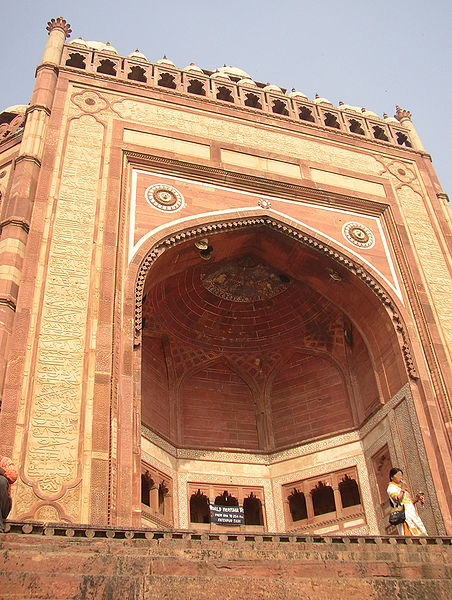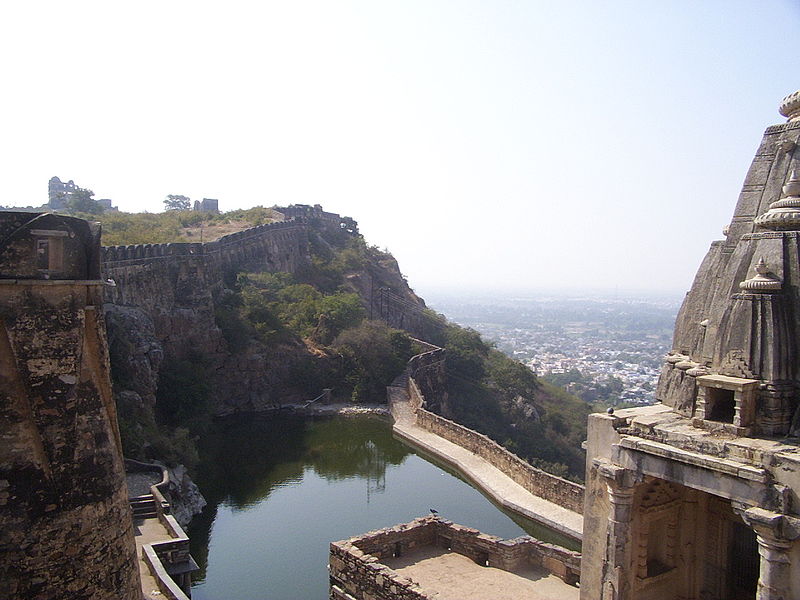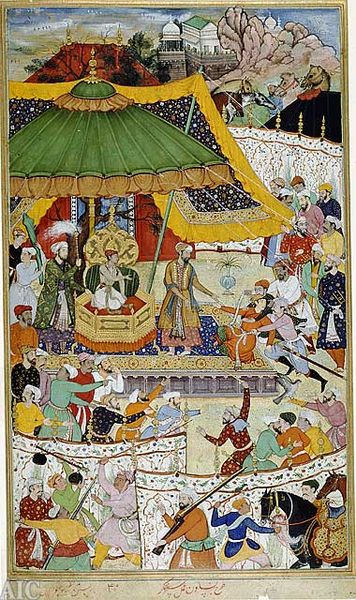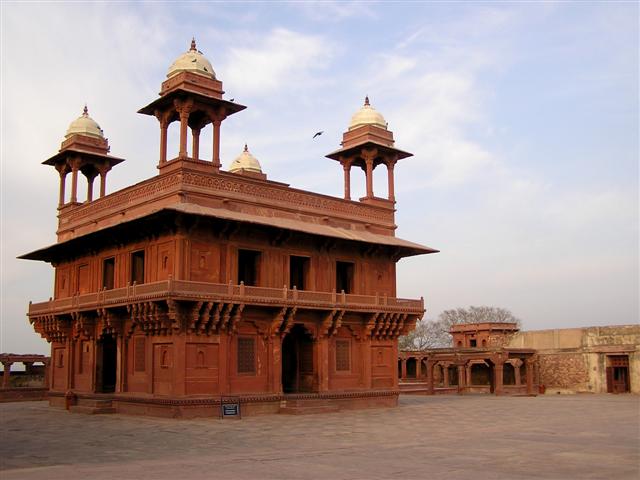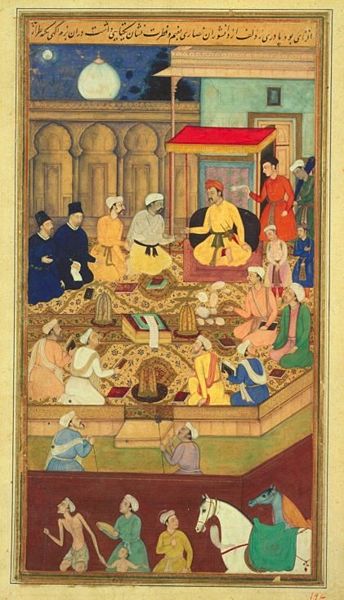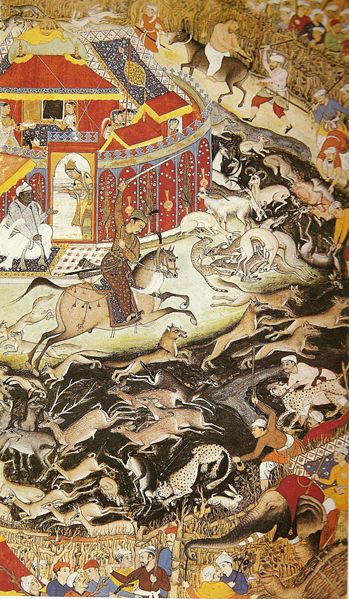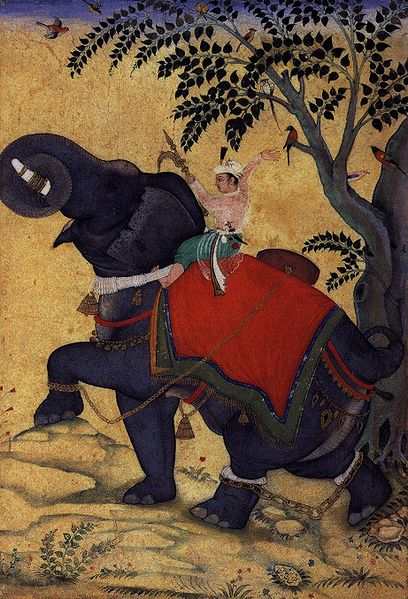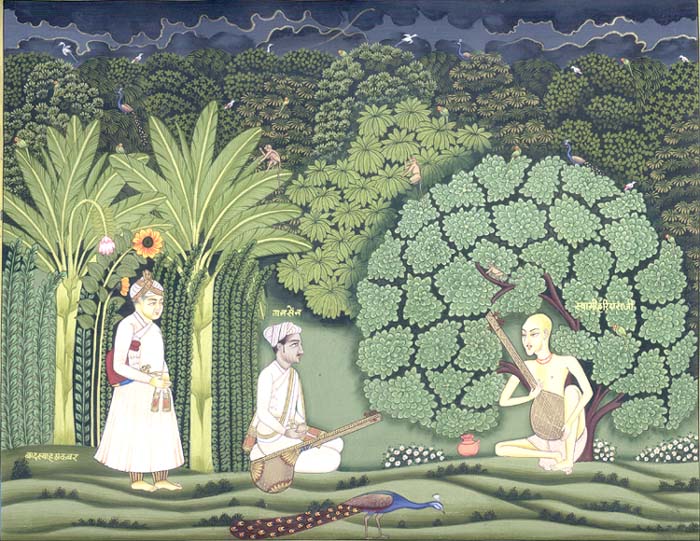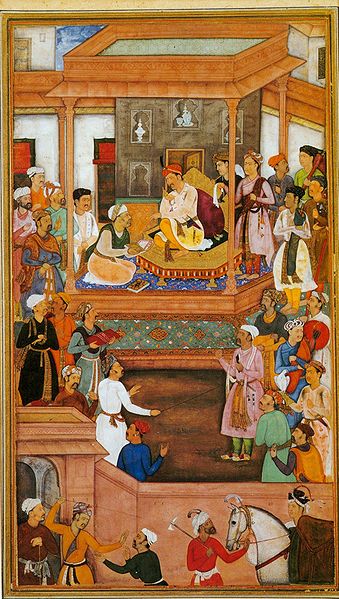<Back to Index>
- Astronomer Asaph Hall III, 1829
- Composer Bernhard Henrik Crusell, 1775
- 3rd Mughal Emperor of India Jalaluddin Muhammad Akbar, 1542
PAGE SPONSOR
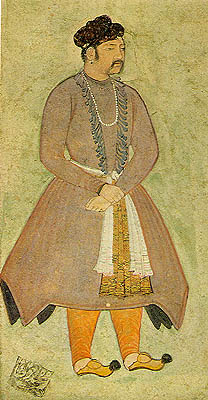
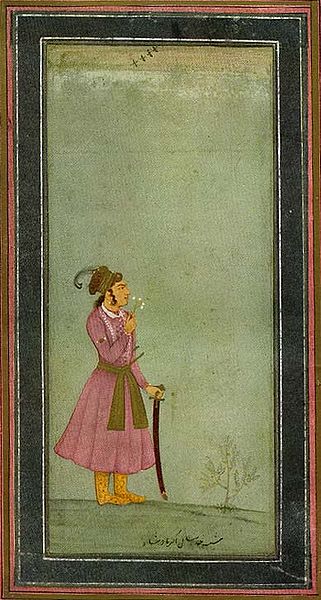
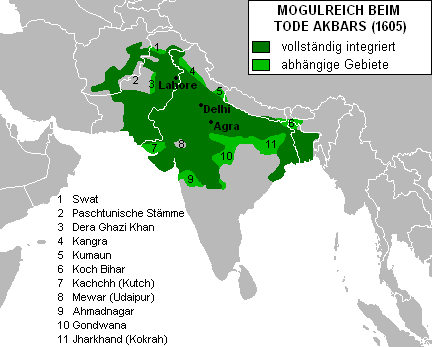
Jalaluddin Muhammad Akbar (جلال الدین محمد اکبر Jalāl ud-Dīn Muhammad Akbar), also known as Shahanshah Akbar-e-Azam or Akbar the Great (15 October 1542 – 27 October 1605), was the third Mughal Emperor. He was of Timurid descent; the son of Humayun, and the grandson of Babur, the ruler who founded the Mughal dynasty in India. At the end of his reign in 1605 the Mughal empire covered most of the northern and central India and was one of the most powerful empires of its age.
Akbar was fourteen years old when he ascended the Mughal throne in Delhi (February 1556), following the death of his father Humayun. During his reign, he eliminated military threats from the powerful Pashtun descendants of Sher Shah Suri, and at the Second Battle of Panipat he defeated the newly self-declared Hindu king Hemu. It took him nearly two more decades to consolidate his power and bring all the parts of northern and central India into his direct realm. He influenced the whole of the Indian Subcontinent as he ruled a greater part of it as an emperor. As an emperor, Akbar solidified his rule by pursuing diplomacy with the powerful Rajput caste, and by marrying Rajput princesses. Akbar's reign significantly influenced art and culture in the country. He took a great interest in painting, and had the walls of his palaces adorned with murals. Besides encouraging the development of the Mughal school, he also patronised the European style of painting. He was fond of literature, and had several Sanskrit works translated into Persian and Persian scriptures translated in Sanskrit apart from getting many Persian works illustrated by painters from his court. During the early years of his reign, he had an intolerant attitude towards Hindus and the other religions, but he exercised great tolerance after he began marriage alliances with Rajput princesses. His administration included numerous Hindu landlords, courtiers and military generals. He began a series of religious debates where Muslim scholars would debate religious matters with Hindus, Sikhs, Jains, Cārvāka atheists, Jews, and Portuguese Roman Catholic Jesuits. He treated these religious leaders with great consideration, irrespective of their faith, and revered them. He even founded a religion, the Din-i-Ilahi (Divine Faith), which included the teachings of major religions of the world, but it amounted only to a form of personality cult for Akbar and started dissolving after his death.
Akbar was born on 15 October 1542 (the fourth day of Rajab, 949 AH), at the Rajput Fortress of Umerkot in Sindh (in modern day Pakistan), where Emperor Humayun and his recently wedded wife, Hamida Banu Begum of Paat village were taking refuge. At birth Akbar was named Badruddin, because he was born on the night of a badr (full moon). After the capture of Kabul by Humayun, Badruddin's circumcision ceremony was held and his date of birth and name were changed to throw off evil sorcerers and he was re-named Jalalu-d-din Muhammad by Humayun, a name which he had heard in his dream at Lahore.
Popular myth incorrectly records that Akbar, meaning "Great", was a
title given to Akbar by the people of India. In fact he was named Akbar
after his maternal grandfather, Shaikh Ali Akbar Jami. Humayun had been driven into exile in Persia by the Pashtun leader Sher Shah Suri. Akbar did not go to Persia with his parents but grew up in the village of Mukundpur in Rewa (in present day Madhya Pradesh). Akbar and prince Ram Singh I, who later became the Maharajah of Rewa, grew up together and stayed close friends through life. Later, Akbar moved to the eastern parts of the Safavid Empire (now a part of Afghanistan)
where he was raised by his uncle Mirza Askari. He spent his youth
learning to hunt, run, and fight, but he never learned to read or
write. This lifestyle of his childhood made him a daring, powerful and
a brave warrior but he remained illiterate throughout his life.
Although this did not hinder his search of knowledge as it is said
whenever he use to go to bed, there would be somebody reading for the
king. Following the chaos over the succession of Sher Shah Suri's son Islam Shah, Humayun reconquered Delhi in 1555, leading an army partly provided by his Persian ally Tahmasp I. A few months later, Humayun died. Akbar's guardian, Bairam Khan concealed
the death in order to prepare for Akbar's succession. Akbar succeeded
Humayun on 14 February 1556, while in the midst of a war against Sikandar Shah to reclaim the Mughal throne. In Kalanaur, Punjab, the 13 year old Akbar was enthroned by Bairam Khan on a newly constructed platform, which still stands. He was proclaimed Shahanshah (Persian for "King of Kings"). Bairam Khan ruled on his behalf until he came of age. Akbar
decided early in his reign that he should eliminate the threat of Sher
Shah's dynasty, and decided to lead an army against the strongest of
the three, Sikandar Shah Suri, in the Punjab. He left Delhi under the regency of Tardi Baig Khan. Sikandar Shah Suri presented no major concern for Akbar, and often withdrew from territory as Akbar approached. The Hindu king Hemu, however, commanding the Afghan forces, defeated the Mughal Army and captured Delhi on 6 October 1556. Urged by Bairam Khan, who remarshalled the Mughal army before Hemu could consolidate his position, Akbar marched on Delhi to reclaim it. Akbar's army, led by Bairam Khan, met the larger forces of Hemu on November 5, 1556 at the Second Battle of Panipat,
50 miles (80 km) north of Delhi. The battle was going in Hemu's
favour when an arrow pierced Hemu's eye, rendering him unconscious. The
leaderless army soon capitulated and Hemu was captured and executed. The victory also left Akbar with over 1,500 war elephants which
he used to re-engage Sikandar Shah at the siege of Mankot. Sikandar,
along with several local chieftains who were assisting him, surrendered
and so was spared death. With this, the whole of Punjab was annexed to the Mughal empire. Before returning to Agra, Akbar sent a detachment of his army to Jammu, which defeated the ruler Raja Kapur Chand and captured the kingdom. Between 1558 and 1560, Akbar further expanded the empire by capturing and annexing the kingdoms of Gwalior, northern Rajputana and Jaunpur. After a dispute at court, Akbar dismissed Bairam Khan in the spring of 1560 and ordered him to leave on Hajj to Mecca. Bairam left for Mecca, but on his way was goaded by his opponents to rebel. He
was defeated by the Mughal army in the Punjab and forced to submit.
Akbar, however forgave him and gave him the option of either continuing
in his court or resuming his pilgrimage, of which Bairam chose the
latter. After
dealing with the rebellion of Bairam Khan and establishing his
authority. Akbar went on to expand the Mughal empire by subjugating local chiefs and annexing neighbouring kingdoms. The first major conquest was of Malwa in 1561, an expedition that was led by Adham Khan and carried out with such savage cruelty that it resulted in a backlash from the kingdom enabling its ruler Baz Bahadur to recover the territory while Akbar was dealing with the rebellion of Bairam Khan. Subsequently,
Akbar sent another detachment which captured Malwa in 1562, and Baz
Bahadur eventually surrendered to the Mughals and was made an
administrator. Around the same time, the Mughal army also conquered the
kingdom of the Gonds, after a fierce battle between the Asaf Khan, the Mughal governor of Allahabad, and Rani Durgavati, the queen of the Gonds. However,
Asaf Khan misappropriated most of the wealth plundered from the
kingdom, which Akbar subsequently forced him to restore, apart from
installing Durgavati's son as the administrator of the region. Over
the course of the decade following his conquest of Malwa, Akbar brought
most of present day Rajasthan, Gujarat and Bengal under his control. A
major victory in this campaign was the siege of Chittor. The fortress at Chittor, ruled by Maharana Udai Singh,
was of great strategic importance as it lay on the shortest route from
Agra to Gujarat and was also considered a key to central Rajasthan. On
the advice of his nobles, Udai Singh retired to the hills, leaving two
warriors Jaimal and Patta in charge of the fort. The
Mughal army surrounded the fortress in October 1567 and it fell in
February 1568 after a siege of six months. The fort was then stormed by
the Mughal forces, and a fierce resistance was offered by members of
the garrison stationed inside, as well as local peasants who came to
their assistance. The women committed jauhar while over 30000 men were massacred by the Mughal army. It was for the first and last time that Akbar indulged in carnage of this magnitude.
Carthaginian on gaining the Battle of Cannae measured
his success by bushels of rings taken from the fingers of equestrian
roman soldiers and similarly Akbar measured his by the quantity of
cordons of distinction (Janeu or the sacred thread) collected from the fallen rajput soldiers and other civilians of Chittor, which amounted to seventy four and half man (a unit of weight in India equalling 40 kg) by weight. To eternise the memory of this deed the number 74.5 is accursed and marked on a banker's letter in Rajasthan it is the strongest of seals, for "the sin of the sack of Chittor" is invoked on him who violates a letter under the safeguard of this mysterious number. In
commemoration of the gallantry of Jaimal and Patta, he ordered that
stone statues of them seated on elephants be carved and erected at the
chief gate of the Agra Fort. The
fortress was completely destroyed and its gates were carried off to
Agra, while the brass candlesticks taken from the Kalika temple after
its destruction were given to the shrine of Moinuddin Chishti in Ajmer. Akbar celebrated the victory over Chittor and Ranthambore by laying the foundation of a new city, 23 miles (37 km) W.S.W of Agra in 1569. It was called Fatehpur Sikri (city of victory). Akbar,
bolstered by his success, was looking forward to widespread acclamation
as a great conqueror of Islam and his vigorous Islamic policy is
illustrated by Fatahnama-i-Chittor issued by him after the conquest of Chittor at Ajmer, where he stayed for some time en route to Agra, on Ramazan 10, 975 / March 9, 1568, where the infidels (Hindus) are reviled: ..the Omnipotent one who enjoined the task of destroying the wicked infidels (Hindus) on the dutiful mujahids through
the blows of their thunder like scimitars laid down: "Fight them! Allah
will chastise them at your hands and He will lay them low and give you
victory over them". Further on the call to Jihad against Hindu kings of India is raised and also a call to the destruction of Hindu temples: This
is of the grace of my Lord that He may try me whether I am grateful or
ungrateful — we spend our precious time to the best of our ability
in war (ghiza) and Jihad and
with the help of Eternal Allah, who is the supporter of our
ever - increasing empire, we are busy in subjugating the localities,
habitations, forts and towns which are under the possession of the
infidels (Hindus),
may Allah forsake and annihilate all of them, and thus raising the
standard of Islam everywhere and removing the darkness of polytheism
and violent sins by the use of sword. We destroy the places of worship of idols in those places and other parts of India. After Akbar's conquest of Chittor, two major Rajput clans remained opposed to him - the Sisodiyas of Mewar and Hadas of Ranthambore. The latter, reputed to be the most powerful fortress in Rajasthan, was
conquered by the Mughal army in 1569, making Akbar the master of almost
the whole of Rajputana. As a result, most of the Rajput kings,
including those of Bikaner, Bundelkhand and Jaisalmer submitted
to Akbar. Only the clans of Mewar continued to resist Mughal conquest
and Akbar had to fight with them from time to time for the greater part
of his reign. Among the most prominent of them was Maharana Pratap who
declined to accept Akbar's suzerainty and also opposed the marriage
etiquette of Rajputs who had been giving their daughters to Mughals. He
renounced all matrimonial alliances with Rajput rulers who had married
into the Mughal dynasty, refusing such alliances even with the princes of Marwar and Amer until they agreed to sever ties with the Mughals. Having conquered Rajputana, Akbar turned to Gujarat, whose government was in a state of disarray after the death of its previous ruler, Bahadur Shah. The province was a tempting target as it was a center of world trade, it possessed fertile soil and had highly developed crafts. The province had been occupied by Humayun for a brief period, and prior to that was ruled by the Delhi Sultanate. In 1572, Akbar marched to Ahmedabad, which capitulated without offering resistance. He took Surat by siege, and then crossed the Mahi river and defeated his estranged cousins, the Mirzas, in a hard fought battle at Sarnal. During the campaign, Akbar met a group of Portuguese merchants for the first time at Cambay.
Having established his authority over Gujarat, Akbar returned to Agra,
but Mirza - led rebellions soon broke out. Akbar returned, crossing
Rajasthan at great speed on camels and horses, and reached Ahmedabad in
eleven days - a journey that normally took six weeks. Akbar's army of
3000 horsemen then defeated the enemy forces numbering 20000 in a
decisive victory on 2 September 1573. The
conquest of Gujarat marked a significant event of Akbar's reign as it
gave the Mughal empire free access to the sea and control over the rich
commerce that passed through its ports. The territory and income of the
empire were vastly increased. The following year, Akbar marched on Patna, capturing it on 7 August 1574, and subsequently, after a series of battles, defeated the ruler of Bengal, Daud Khan Karrani, at the Battle of Tukaroi on 3 March 1575, thereby annexing the province to the Mughal empire. However, Daud, who had fled to Orissa,
regrouped his forces the following year and recaptured Bengal. Akbar
then sent in reinforcements and Daud was finally defeated, captured and
killed in the Battle of Rajmahal in July 1576. The Mughal army also conquered Kabul (1581), Kashmir (1586), and Kandesh (1601), among others. Akbar installed a governor over each of the conquered provinces. Akbar's system of central government was based on the system that had evolved since the Delhi Sultanate, but the functions of various departments were carefully reorganised by laying down detailed regulations for their functioning: Akbar
departed from the policy of his predecessors in his treatment of the
territories he conquered. Previous Mughals extracted a large tribute
from these rulers and then leave them to administer their dominions
autonomously; Akbar integrated them into his administration, providing
them the opportunity to serve as military rulers. He thus
simultaneously controlled their power while increasing their prestige
as a part of the imperial ruling class. Some of these rulers went on to become the navaratnas in Akbar's court. Akbar set about reforming the administration of his empire's land revenue by adopting a system that had been used by Sher Shah Suri. A cultivated area was measured and taxed through fixed rates based on
the area's crop and productivity. However, this placed hardship on the
peasantry because tax rates were fixed on the basis of prices
prevailing in the imperial court, which were often higher than those in
the countryside. Akbar
changed to a decentralised system of annual assessment, but this
resulted in corruption among local officials and was abandoned in 1580,
to be replaced by a system called the dahsala. Under
the new system, revenue was calculated as one - third of the average
produce of the previous ten years, to be paid to the state in cash.
This system was later refined, taking into account local prices, and
grouping areas with similar productivity into assessment circles.
Remission was given to peasants when the harvest failed during times of
flood or drought. Akbar's dahsala system is credited to Raja Todar Mal, who also served as a revenue officer under Sher Shah Suri, and
the structure of the revenue administration was set out by the latter
in a detailed memorandum submitted to the emperor in 1582 - 83. Other
local methods of assessment continued in some areas. Land which was
fallow or uncultivated was charged at concessional rates. Akbar
also actively encouraged the improvement and extension of agriculture.
The village continued to remain the primary unit of revenue assessment. Zamindars of
every area were required to provide loans and agricultural implements
in times of need, to encourage farmers to plough as much land as
possible and to sow seeds of superior quality. In turn, the zamindars
were given a hereditary right to collect a share of the produce.
Peasants had a hereditary right to cultivate the land as long as they
paid the land revenue. While
the revenue assessment system showed concern for the small peasantry,
it also maintained a level of distrust towards the revenue officials.
Revenue officials were guaranteed only three - quarters of their salary,
with the remaining quarter dependent on their full realisation of the
revenue assessed.
Akbar organized his army as well as the nobility by means of a system called the mansabdari. Under this system, each officer in the army was assigned a rank (a mansab), and assigned a number of cavalry that he had to supply to the imperial army. The mansabdars were
divided into 33 classes. The top three commanding ranks, ranging from
7000 to 10000 troops, were normally reserved for princes. Other ranks
between 10 and 5000 were assigned to other members of the nobility. The
empire's permanent standing army was quite small and the imperial forces mostly consisted of contingents maintained by the mansabdars. Persons were normally appointed to a low mansab and then promoted, based on their merit as well as the favour of the emperor. Each mansabdar was
required to maintain a certain number of cavalrymen and twice that
number of horses. The number of horses was greater because they had to
be rested and rapidly replaced in times of war. Akbar employed strict
measures to ensure that the quality of the armed forces was maintained
at a high level; horses were regularly inspected and only Arabian horses were normally employed. The mansabdars were remunerated well for their services and constituted the highest paid military service in the world at the time.
Akbar was a follower of Salim Chishti, a holy man who lived in the region of Sikri near Agra.
Believing the area to be a lucky one for himself, he had a mosque
constructed there for the use of the saint. Subsequently, he celebrated
the victories over Chittor and Ranthambore by laying the foundation of
a new walled capital, 23 miles (37 km) west of Agra in 1569, which
was named Fatehpur ("town of victory") after the conquest of Gujarat in 1573 and subsequently came to be known as Fatehpur Sikri in order to distinguish it from other similarly named towns. Palaces
for each of Akbar's senior queens, a huge artificial lake, and
sumptuous water filled courtyards were built there. However, the city
was soon abandoned and the capital was moved to Lahore in
1585. The reason may have been that the water supply in Fatehpur Sikri
was insufficient or of poor quality. Or, as some historians believe,
Akbar had to attend to the northwest areas of his empire and therefore
moved his capital northwest. Other sources indicate Akbar simply lost
interest in the city or
realised it was not militarily defensible. In 1599, Akbar shifted his
capital back to Agra from where he reigned until his death. The
practice of giving Hindu princesses to Muslim kings in marriage was
known much before Akbar's time, but in most cases these marriages did
not lead to any stable relations between the families involved, and the
women were lost to their families and did not return after marriage. However,
Akbar's policy of matrimonial alliances marked a departure from
previous practice in that the marriage itself marked the beginning of a
new order of relations, wherein the Hindu Rajputs who married their
daughters or sisters to him would be treated on par with his Muslim
fathers and brothers in-law in all respects except being able to dine
and pray with him or take Muslim wives. These Rajputs were made members
of his court and their daughters' or sisters' marriage to a Muslim
ceased to be a sign of degradation, except for certain orthodox
elements who still considered it a sign of humiliation. The Kacchwaha Rajput, Raja Bharmal, of Amber,
who had come to Akbar's court shortly after the latter's accession,
entered into an alliance by giving his daughter Harkha Bai in marriage
to the emperor. Harkha Bai became Muslim was renamed Mariam-uz-Zamani.
After her marriage she was treated as an outcaste by her Hindu family
and for the rest of her life never visited Amer. She was not assigned
any significant place either in Agra or Delhi, but rather a small
village in the Bharatpur district. She died in 1623. A mosque was built in her honor by her son Jahangir in Lahore. Bharmal was made a noble of high rank in the imperial court, and subsequently his son Bhagwant Das and grandson Man Singh also rose to high ranks in the nobility. Other
Rajput kingdoms also established matrimonial alliances with Akbar, but
matrimony was not insisted on as a precondition for forming alliances.
Two major Rajput clans remained aloof – the Sisodiyas of Mewar and Hadas of Ranthambore. In another turning point of Akbar's reign, Raja Man Singh I
of Amber went with Akbar to meet the Hada leader, Surjan Hada, to
effect an alliance. Surjan accepted an alliance on the condition that
Akbar did not marry any of his daughters. Consequently, no matrimonial
alliance was entered into, yet Surjan was made a noble and placed in
charge of Garh - Katanga. Certain
other Rajput nobles did not like the idea of their kings marrying their
daughters to Mughals. Rathore Kalyandas threatened to kill both Mota
Raja Rao Udaisingh and Jahangir because Udai Singh had decided to marry his daughter to Jahangir. Akbar on
hearing this ordered imperial forces to attack Kalyandas at Siwana. Kalyandas died fighting along with his men and the women of Siwana committed Jauhar. The
political effect of these alliances was significant. While some Rajput
women who entered Akbar's harem converted to Islam, they were generally
provided full religious freedom, and their relatives, who continued to
remain Hindu, formed a significant part of the nobility and served to
articulate the opinions of the majority of the common populace in the
imperial court. The
interaction between Hindu and Muslim nobles in the imperial court
resulted in exchange of thoughts and blending of the two cultures.
Further, newer generations of the Mughal line represented a merger of
Mughal and Rajput blood, thereby strengthening ties between the two. As
a result, the Rajputs became the strongest allies of the Mughals, and
Rajput soldiers and generals fought for the Mughal army under Akbar,
leading it in several campaigns including the conquest of Gujarat in
1572. Akbar's
policy of religious tolerance ensured that employment in the imperial
administration was open to all on merit irrespective of creed, and this
led to an increase in the strength of the administrative services of
the empire.
At
the time of Akbar's ascension in 1556, the Portuguese had established
several fortresses and factories on the western coast of the
subcontinent, and largely controlled navigation and sea trade in that
region. As a consequence of this colonialism, all other trading
entities were subject to the terms and conditions of the Portuguese,
and this was resented by the rulers and traders of the time. The
Mughal empire acquired its first access to the sea after Akbar's
conquest of Gujarat in 1572, and for the first few years, conscious of
the threat posed by the presence of the Portuguese, remained content
with obtaining a cartaz from them for sailing in the Persian Gulf region. At
the initial meeting of the Mughals and the Portuguese during the siege
of Surat in 1572, the Portuguese, recognising the superior strength of
the Mughal army, chose to adopt diplomacy instead of war, and the
Portuguese Governor, upon the request of Akbar, sent him an ambassador
to establish friendly relations. Akbar accepted the offer of diplomacy,
in order to facilitate the safe passage of the members of his harem on
their projected pilgrimage to Mecca. In 1573, he issued a firman directing his administrative officials in Gujarat not to disturb the Portuguese in their adjoining territory of Daman. The Portuguese, in turn, issued passes for the members of Akbar's family to go on Hajj to Mecca. The cartaz thus issued made mention of the extraordinary status of the vessel and the special status to be accorded to its occupants. When Akbar was still a child the Ottoman Admiral Seydi Ali Reis visited the Mughal Emperor Humayun; during the later years of Akbar's rule another Ottoman Admiral Kurtoğlu Hızır Reis arrived on the shores of the Mughal Empire. These Ottoman Admirals sought to end the growing threats of the Portuguese Empire during their Indian Ocean campaigns. In 1576 Akbar sent a very large contingent of pilgrims led by Yahya Saleh, including members of his harem, on Hajj by two ships from Surat, which reached the port of Jeddah in 1577 and then proceeded towards Mecca and Medina. Four more caravans were sent from 1577 to 1580, with gifts and Sadaqah for
the authorities of Mecca and Medina. The pilgrims in these caravans
were poor, however, and their stay strained the resources of these
cities. The Ottoman authorities requested that the pilgrims return home, but the ladies of the harem did not want to leave Hejaz. At length they were forced to return. These events persuaded Akbar to stop sending Hajj caravans and Sadaqat to
Mecca and Medina. In 1586, Akbar expressed a desire to form an alliance
with the Portuguese in order to attack the Ottoman Turks. In 1587 a Portuguese fleet sent to attack Yemen was routed and defeated by the Ottoman Navy. The Mughal - Portuguese alliance fell through because of the continuing pressure by the Mughal vassals at Janjira.
The Safavids and the Mughals had a long history of diplomatic relationship, with the Safavid ruler Tahmasp I having provided refuge to Humayun when
he had to flee the Indian subcontinent following his defeat by Sher
Shah Suri. During the sixteenth and seventeenth centuries, the two
empires, along with the Ottoman Empire to
the west, were the site of major power struggles in Asia. However, the
Safavids differed from the Mughals and the Ottomans in following the Shiite sect of Islam as opposed to the Sunni sect practised by the other two. One of the longest standing disputes between the Safavids and the Mughals pertained to the control of the city of Qandahar in the Hindukush region, forming the border between the two empires. The
Hindukush region was militarily very significant owing to its
geography, and this was well recognised by strategists of the times. Consequently,
the city, which was being administered by Bairam Khan at the time of
Akbar's accession, was invaded and captured by the Persian ruler Husain
Mirza, a cousin of Tahmasp I, in 1558. Subsequent
to this, Bairam Khan sent an envoy to Tamahsp I's court, in an effort
to maintain peaceful relations with the Safavids. This gesture was
reciprocated and a cordial relationship continued to prevail between
the two empires during the first two decades of Akbar's reign. However,
the death of Tamahsp I in 1576 resulted in civil war and instability in
the Safavid empire, and diplomatic relations between the two empires
ceased for more than a decade, and were restored only in 1587 following the accession of Shah Abbas to the Safavid throne. Shortly
afterwards, Akbar's army completed its annexation of Kabul, and in
order to further secure the north-western boundaries of his empire, it
proceeded to Qandahar. The city capitulated without resistance on April
18, 1595, and the ruler Muzaffar Hussain moved into Akbar's court. Qandahar continued to remain in Mughal possession, and the Hindukush the empire's western frontier, for several decades until Shah Jahan's expedition into Badakhshan in 1646. Diplomatic relations continued to be maintained between the Safavid and Mughal courts until the end of Akbar's reign.
Vincent Arthur Smith observes
that the merchant Mildenhall was employed in 1600 while the
establishment of the Company was under adjustment to bear a letter from Queen Elizabeth to Akbar requesting liberty to trade in his dominions on terms as good as those enjoyed by the Portugese. Akbar, as well as his mother and other members of his family, are believed to have been Sunni Hanafi Muslims. His early days were spent in the backdrop of an atmosphere in which liberal sentiments were encouraged and religious narrow mindednness was frowned upon. From the 15th century, a number of rulers in various parts of the country adopted a more liberal policy of religious tolerance, attempting to foster communal harmony between Hindus and Muslims. These sentiments were further encouraged by the teachings of popular saints like Guru Nanak, Kabir and Chaitanya, the verses of the Persian poet Hafez which advocated human sympathy and a liberal outlook, as well as the Timurid ethos of religious tolerance that persisted in the polity right from the times of Timur to Humayun, and influenced Akbar's policy of tolerance in matters of religion. Further, his childhood tutors, who included two Irani Shias, were largely above sectarian prejudices, and made a significant contribution to Akbar's later inclination towards religious tolerance. One of Akbar's first actions after gaining actual control of the administration was the abolition of jizya, a tax which all non-Muslims were required to pay, in 1562. The tax was reinstated in 1575, a move which has been viewed as being symbolic of vigorous Islamic policy, but was again repealed in 1580. Akbar adopted the Sulh-e-Kul concept of Sufism as
official policy, integrated many Hindus into high positions in the
administration, and removed restrictions on non-Muslims, thereby
bringing about a composite and diverse character to the nobility. As
a mark of his respect for all religions, he ordered the observance of
all religious festivals of different communities in the imperial court. Akbar's attitudes towards his Hindu subjects were an amalgam of Timurid, Persian and Indian ideas of sovereignty. The liberal principles of the empire were strengthened by incorporating Hindus into the nobility. However, historian Dasharatha Sharma states that court histories like the Akbarnama idealize Akbar's religious tolerance, and give Akbar more credit than he is due. Akbar
in his early years was not only a practising Muslim but is also
reported to have had an intolerant attitude towards Hindus. In 1579, towards the middle of his reign, he boasted of being a great conqueror of Islam in a letter to the ruler of Turan, Abdullah Khan and was also looked upon by orthodox Muslim elements as a devout believer committed to defending the religion against infidels. His
attitude towards the Hindu religion and its practices did not have
appreciable impact after his marriage alliances with Rajput princesses
which all took place in early 1560s though he was also perceived as not
being averse to performing Hindu rituals despite his Islamic beliefs. Akbar's
Hindu generals could not construct temples without the emperor's
permission. In Bengal, after Man Singh started the construction of a
temple in 1595, Akbar ordered him to convert it into a mosque. He gave two villages for the upkeep of a mosque and a Madrasa which was setup by destroying a Hindu temple. During
the early part of Akbar's reign, his army was responsible for the
demolition of rich Hindu temples which had gold deities in the Doab region.
However, he subsequently made amends for the same by donating a golden
umbrella to cover the deity at a temple which had been demolished, and
allowing the conversion of a mosque into Hindu temple at Kurukshetra. Akbar regularly hold discussions with Jain scholars and was also greatly impacted by some of their teachings. His first encounter with Jain rituals was when he saw a Jain shravika named Champa's procession after a six month long fast. Impressed by her power and devotion, he invited her guru or spiritual teacher Acharya Hiravijaya Suri to Fatehpur Sikri. Acharya accepted the invitation and began his march towards the Mughal capital from Gujarat. Akbar
was greatly impressed by the scholastic qualities and character of the
Acharya. He held several debates and discussions on religion and
philosophy in his courts. Arguing with Jains, Akbar remained sceptical of their rituals, and yet became convinced by their arguments for vegetarianism and end up deploring the eating of all flesh. The Indian Supreme Court too
has cited examples of co-existence of Jain and Mughal architecture.
Terming Mughal emperor Akbar as "the architect of modern India", a
bench said that Akbar, who had great respect for Jainism, had declared "Amari Ghosana" banning the killing of animals during Paryushan and Mahavir Jayanti. He rolled back the Jazia tax from Jain pilgrim places like Palitana. These farmans were also issued in 1592, 1584 and 1598.
During
the early part of his reign, Akbar adopted an attitude of suppression
towards Muslim sects that were condemned by the orthodoxy as heretical. In 1567, on the advice of Shaikh Abdu'n Nabi, he ordered the exhumation of Mir Murtaza Sharifi Shirazi - a Shia buried in Delhi - because of the grave's proximity to that of Amir Khusrau, arguing that a "heretic" could not be buried so close to the grave of a Sunni saint, reflecting a restrictive attitude towards the Shia, which continued to persist till the early 1570s. He suppressed Mahdavism in
1573 during his campaign in Gujarat, in the course of which the Mahdavi
leader Bandagi Miyan Shiek Mustafa was arrested and brought in chains
to the court for debate and released after eighteen months. However,
as Akbar increasingly came under the influence of pantheistic Sufi
mysticism from the early 1570s, it caused a great shift in his outlook
and culminated in his shift from orthodox Islam as traditionally
professed, in favor of a new concept of Islam transcending the limits
of religion. Consequently,
during the latter half of his reign, he adopted a policy of tolerance
towards the Shias and declared a prohibition on Shia - Sunni conflict,
and the empire remained neutral in matters of internal religious
conflict within Islam.
In 1580, a rebellion broke out in the eastern part of Akbar's empire, and a number of fatwas, declaring Akbar to be a heretic, were issued by Qazis.
Akbar suppressed the rebellion and handed out severe punishments to the
Qazis. In order to further strengthen his position in dealing with the
Qazis, Akbar issued a mazhar or declaration that was signed by all major ulemas in 1579. The mahzar asserted that Akbar was the Khalifa of the age, the rank of the Khalifa was higher than that of a Mujtahid,
in case of a difference of opinion among the Mujtahids, Akbar could
select any one opinion and could also issue decrees which did not go
against the nass. Given the prevailing Islamic sectarian conflicts in various parts of the country at that time, it is believed that the Mazhar helped in stabilizing the religious situation in the empire. It made Akbar very powerful due to the complete supremacy accorded to the Khalifa by Islam, and also helped him eliminate the religious and political influence of the Ottoman Khalifa over his subjects, thus ensuring their complete loyalty to him.
Akbar
met Portuguese Jesuit priests and sent an ambassador to Goa, requesting
them to send two missionaries to his court so that he could understand Christian doctrines better.
In response, the Portuguese sent Monserrate and Acquaviva who remained
at Akbar's court for three years and left accounts of their visit. In 1603 a written firman was granted at the request of the Christian priests allowing them to make willing converts. Even
armed with the firman, however, the missionaries found it extremely
difficult to carry out their work: the Viceroy of Lahore, Qulij Khan, a
staunch Muslim official, employed tactics of harassment that caused
many Christians to flee from Lahore and Father Pinheiro went in fear of death. Akbar
was deeply interested in religious and philosophical matters. An
orthodox Muslim at the outset, he later came to be influenced by Sufi mysticism
that was being preached in the country at that time, and moved away
from orthodoxy, appointing to his court several talented people with
liberal ideas, including Abul Fazl, Faizi and Birbal. In 1575, he built a hall called the Ibadat Khana ("House of Worship")
at Fatehpur Sikri, to which he invited theologians, mystics and
selected courtiers renowned for their intellectual achievements and
discussed matters of spirituality with them. These
discussions, initially restricted to Muslims, were acrimonious and
resulted in the participants shouting at and abusing each other. Upset
by this, Akbar opened the Ibadat Khana to people of all religions as
well as atheists, resulting in the scope of the discussions broadening
and extending even into areas such as the validity of the Quran and
the nature of God. This shocked the orthodox theologians, who sought to
discredit Akbar by circulating rumours of his desire to forsake Islam. Akbar's
efforts to evolve a meeting point among the representatives of various
religions was not very successful, as each of them attempted to assert
the superiority of their respective religions by denouncing other
religions. Meanwhile, the debates at the Ibadat Khana grew more
acrimonious and, contrary to their purpose of leading to a better
understanding among religions, instead led to greater bitterness among
them, resulting to the discontinuance of the debates by Akbar in 1582. However,
his interaction with various religious theologians had convinced him
that despite their differences, all religions had several good
practices, which he sought to combine into a new religious movement
known as Din-i-Ilahi. However, some modern scholars claim that Akbar did not initiate a new religion and did not use the word Din-i-Ilahi. At about this time, he began to indicate that he had lost faith in the creed of the prophet of Mecca. The
purported Din-i-Ilahi was more of an ethical system and is said to have
prohibited lust, sensuality, slander and pride, considering them sins.
Piety, prudence, abstinence and kindness are the core virtues. The soul
is encouraged to purify itself through yearning of God. Celibacy
was respected, chastity enforced, the slaughter of animals was
forbidden and there were no sacred scriptures or a priestly hierarchy. However,
a leading Noble of Akbar's court, Aziz Koka, wrote a letter to him from
Mecca in 1594 arguing that the Din-i-Ilahi promoted by Akbar amounted
to nothing more than a desire on Akbar's part to portray himself as "a
new prophet". To commemorate Din-e-Ilahi, he changed the name of Prayag to Allahabad (pronounced as ilahabad) in 1583. It
has been argued that the theory of Din-i-Ilahi being a new religion was
a misconception which arose due to erroneous translations of Abul
Fazl's work by later British historians. However, it is also accepted that the policy of sulh-e-kul,
which formed the essence of Din-i-Ilahi, was adopted by Akbar not
merely for religious purposes, but as a part of general imperial
administrative policy. This also formed the basis for Akbar's policy of
religious toleration. At
the time of Akbar's death in 1605 there were no signs of discontent
amongst his Muslim subjects and the impression of even a theologian
like Abdu'l Haq was that Akbar remained a Muslim. Akbar's reign was chronicled extensively by his court historian Abul Fazal in the books Akbarnama and Ain-i-akbari. Other contemporary sources of Akbar's reign include the works of Badayuni, Shaikhzada Rashidi and Shaikh Ahmed Sirhindi. Akbar was an artisan, warrior, artist, armourer, blacksmith, carpenter, emperor, general, inventor, animal trainer (reputedly keeping thousands of hunting cheetahs during his reign and training many himself), lacemaker, technologist and theologian. Akbar
was said to have been a wise emperor and a sound judge of character.
His son and heir, Jahangir, wrote effusive praise of Akbar's character
in his memoirs, and dozens of anecdotes to illustrate his virtues. According to Jahangir, Akbar's complexion was like the yellow of wheat. Antoni de Montserrat, the Catalan Jesuit
who visited his court described him as plainly white. Akbar was not
tall but powerfully built and very agile. He was also noted for various
acts of courage. One such incident occurred on his way back from Malwa to Agra when Akbar was 19 years of age. Akbar
rode alone in advance of his escort and was confronted by a tigress
who, along with her cubs, came out from the shrubbery across his path.
When the tigress charged the emperor, he was alleged to have dispatched
the animal with his sword in a solitary blow. His approaching
attendants found the emperor standing quietly by the side of the dead
animal. Abul
Fazal, and even the hostile critic Badayuni, described him as having a
commanding personality. He was notable for his command in battle, and,
"like Alexander of Macedon,
was always ready to risk his life, regardless of political
consequences". He often plunged on his horse into the flooded river
during the rainy seasons and safely crossed it. He rarely indulged in
cruelty and is said to have been affectionate towards his relatives. He
pardoned his brother Hakim, who was a repented rebel. But on rare
occasions, he dealt cruelly with offenders, such as his maternal uncle
Muazzam and his foster - brother Adham Khan, who was twice defenestrated for drawing Akbar's wrath. He is said to have been extremely moderate in his diet. Ain-e-Akbari mentions that during his travels and also while at home, Akbar drank water from the Ganges river, which he called ‘the water of immortality’. Special people were stationed at Sorun and later Haridwar to dispatch water, in sealed jars, to wherever he was stationed. According toJahangir's
memoirs, he was fond of fruits and had little liking for meat, which he
stopped eating in his later years. He was more religiously tolerant
than many of the Muslim rulers before and after him. Jahangir wrote: "As
in the wide expanse of the Divine compassion there is room for all
classes and the followers of all creeds, so... in his
dominions, ... there was room for the professors of opposite
religions, and for beliefs good and bad, and the road to altercation
was closed. Sunnis and Shias met in one mosque, and Franks and Jews in
one church, and observed their own forms of worship." To defend his stance that speech arose from hearing, he carried out a language deprivation experiment,
and had children raised in isolation, not allowed to be spoken to, and
pointed out that as they grew older, they remained mute.
During Akbar's reign, the ongoing process of inter-religious discourse and syncretism resulted
in a series of religious attributions to him in terms of positions of
assimilation, doubt or uncertainty, which he either assisted himself or
left unchallenged. Such hagiographical accounts of Akbar traversed a wide range of denominational and sectarian spaces, including several accounts by Parsis, Jains and Jesuit missionaries, apart from contemporary accounts by Brahminical and Muslim orthodoxy. Existing
sects and denominations, as well as various religious figures who
represented popular worship felt they had a claim to him. The diversity
of these accounts is attributed to the fact that his reign resulted in
the formation of a flexible centralised state accompanied by personal
authority and cultural heterogeneity. The Akbarnāma (Persian: /Lang-Ur اکبر نامہ), which literally means Book of Akbar, is an official biographical account of Akbar, the third Mughal Emperor (r. 1556 – 1605), written in Persian. It includes vivid and detailed descriptions of his life and times. The work was commissioned by Akbar, and written by Abul Fazl, one of the Nine Jewels (Hindi: Navaratnas)
of Akbar’s royal court. It is stated that the book took seven years to
be completed and the original manuscripts contained a number of
paintings supporting the texts, and all the paintings represented the Mughal school of painting, and work of masters of the imperial workshop, including Basawan, whose use of portraiture in its illustrations was an innovation in Indian art. On 3 October 1605, Akbar fell ill with an attack of dysentery,
from which he never recovered. He is believed to have died on or about
26 October 1605, after which his body was buried at a mausoleum in Sikandra, Agra. Akbar
left behind a rich legacy both for the Mughal Empire as well as the
Indian subcontinent in general. He firmly entrenched the authority of
the Mughal empire in India and beyond, after it had been threatened by
the Afghans during his father's reign, establishing its military and diplomatic superiority. During
his reign, the nature of the state changed to a secular and liberal
one, with emphasis on cultural integration. He also introduced several
far-sighted social reforms, including prohibiting sati, legalising widow remarriage and raising the age of marriage. Citing Akbar's melding of the disparate 'fiefdoms' or India into the Mughal Empire as well as the lasting legacy of "pluralism and tolerance" that "underlies the values of the modern republic of India", Time magazine included his name in its list of top 25 world leaders.
